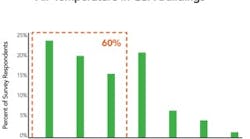Thermal comfort, like so many aspects of environmental control, is far easier to define than achieve. If it were simply a matter of regulating the thermostat, all office dwellers would be satisfied with the thermal environment.
But it isn’t, and they aren’t.
The fact that ASHRAE indicates thermal comfort is achieved when environmental conditions satisfy 80 percent of office occupants suggests just how difficult it is to please all occupants even some of the time.
Nor is it a given that building owners can satisfy the majority without incurring significant equipment and operating costs. Owners are also all too familiar with costs of another kind – productivity declines resulting from conditions that are less than just right. “Study after study shows that a building owner’s greatest expense isn’t equipment or operating costs, but losses in occupant productivity,” says Simon Turner, president of Fairfax, VA-based Healthy Buildings International.
The most frequent occupant complaint? “It’s too hot or too cold,” Turner says.
Those conditions aren’t merely a function of room temperature, but of radiant temperature, air velocity, relative humidity, and radiation (see Thermal Dynamics sidebar, below), whose values may vary from application to application. The good news is that ASHRAE Standard 55-2004: Thermal Environmental Conditions for Human Occupancy specifies methods for determining the values required to achieve acceptable thermal conditions in building environments.
Strategies for Success in LEED: An Article, A Partnership of Buildings and USGBC
Continuing Education Credits
This article is part of Strategies for Success in LEED, a series of articles and webinars produced by the U.S. Green Building Council that satisfies GBCI credential maintenance requirements for LEED Professionals (1 hour). The article’s learning objectives appear below. A test and instructions to apply for credit are available online.
This article has been approved by BOMI and AIA for continuing education credits.
Learning Objectives
Upon the completion of this article, you’ll be able to:
- Understand the relationship between thermal comfort and occupant productivity.
- Recognize the benefits and challenges of displacement ventilation.
- Understand examples of computer modeling for thermal comfort.
- Recognize the relationships between thermal comfort and energy usage.
The bad news: There is no similar method for regulating an occupant’s clothing or metabolism, which explains why two people sitting next to one another may perceive significant differences in temperature. “More often than not, limitations aren’t with the equipment,” says Turner. “They’re with the people the equipment is intended to serve.”
And, in some cases, with budgets. Earlier efforts to improve occupant conditions, particularly workstations with dedicated air-handling systems and controls, collapsed under the weight of their costs. “It was simply too expensive, if you can imagine applications involving a seven- or eight-story building and 1,000 or so occupants,” says Turner.
Displaced Spaces
More recently, owners have begun evaluating other promising alternatives. A prominent one is displacement ventilation, a cooling concept that introduces low-velocity air at or near floor level and employs buoyancy forces generated by heat sources, including people and equipment, to remove heat. According to Turner, convection from heat sources prompts vertical air motion into the upper zone, where return outlets located at or near the ceiling extract the air. The purported benefits include improved thermal comfort and indoor air quality.
There also may be substantial energy savings, since incoming air is heated or cooled to about 65 degrees F. – considerably warmer than air for conventional air conditioning. Higher supply air temperatures also increase the potential for free cooling in temperate climates.
There are caveats, of course. Air diffusion, for instance, may be obstructed by workspace partitions, just as air exhaust may be compromised by low ceiling heights. Although 9-foot-high ceilings are adequate, higher ceilings – 12 feet is ideal – enhance the benefits of stratification.
Thermal Dynamics
In addition to body metabolism and work attire, thermal comfort is a function of four environmental conditions related to building envelope, HVAC system, lighting, and the nature of the occupancy.
Metabolism and attire are the wild cards, which is all the more reason to be well schooled in:
- Air temperature – The temperature of air surrounding the body.
- Radiant temperature – The heat that radiates from a warm object, including furnaces. Radiant temperature has an even greater influence than air temperature on how occupants gain heat from the environment or lose it to the environment. The mean radiant temperature is a measure of the radiative properties of all objects and surfaces. Cold walls or windows, for example, can greatly reduce a room’s mean radiant temperature, causing significant thermal discomfort.
- Air velocity – The speed of air moving across the occupant. Moving air in warm or humid conditions can increase heat loss through convection. With convective cooling, the air first gains heat by conduction, radiation, or evaporation, then removes it by motion. An absence of air velocity may create “stuffy” conditions.
- Relative humidity – The ratio between the amount of water vapor in the air and the maximum amount of water vapor the air can hold at a particular temperature. Relative humidity between 40 percent and 70 percent generally doesn’t affect thermal comfort. It is also the range of choice in offices with computers.
A potentially larger problem is climate, particularly in regions requiring additional heating and cooling capacity to contend with fluctuations in source air temperature. Although low-velocity displacement systems can be equipped to provide heating, the goal with heating is a well-mixed space. As such, supplemental perimeter heating may be required to maintain thermal comfort during winter months.
Given the mixed picture, owners will have to do the math to determine whether region, occupancy, and workspace are well suited to displacement ventilation, both as a matter of comfort and efficiency.
The two aren’t mutually exclusive, as the U.S. General Services Administration, the nation’s largest landlord, discovered after surveying 22 buildings and 6,000 federal employees, the results of which are documented in Energy Savings and Performance Gains in GSA Buildings: Seven Cost-Effective Strategies.
The upshot: What’s good for the energy bill can be good for occupant comfort. An example is raising temperatures from 74 degrees F. to 78 degrees F. during summer months. GSA’s rationale: “Of the workstations measured during summer, 40 percent were colder than the ambient temperature recommended in ASHRAE 55-2004. Correlated satisfaction questionnaire responses showed that 61 percent of end users felt too cold.” (Other studies have recommended lowering temperature setpoints during winter months to reduce the contrast between outdoor and indoor temperatures.) GSA also discovered that high-performance HVAC filters lowered total HVAC costs and improved air quality and movement, conditions that improved end-user satisfaction.
Improving access to daylight and swapping CRT monitors for LCDs also boosted occupant productivity; however, GSA found that the gain is due to better luminance (the monitors) and a greater sense of well being (the outdoor vistas) rather than improved thermal conditions. Reducing the number of printers and copiers not only enhances teamwork, but also saves energy. The GSA report recommends a 1:25 ratio of machines to occupants; the current ratio is 1:5.
A costly and fairly obvious GSA recommendation is upgrades for single-pane windows. Owners and engineers know the drill: High initial costs are offset by greater energy savings, while occupants, relieved of drafts, demonstrate improved productivity.
Modeling Thermal Conditions
Such large-scale projects as window upgrades may benefit from computer modeling, a software technology that addresses some conditions that ASHRAE 55-2004 doesn’t. In a study on radiant heating, for instance, the University of California-Berkeley (UCB) noted that “ASHRAE 55-2004 defines temperature limits for floors and ceilings that are independent of the air temperature in the space. ... [However,] the acceptability of floor and ceiling surface temperatures clearly depends on air temperature.”
To connect the dots, UCB employed a thermal-comfort simulation model to examine surface temperatures across a range of air temperatures, concluding that a 1 degree C. increase in air temperature can be offset by a decrease in floor or ceiling temperature of approximately 5 degrees C. Similar modeling, the study suggests, “may provide new options for energy-efficient building operation.”
The Thermal Help Desk
Receiving complaints about spaces that are too hot or too cold? Unless the building’s design is flawed, the majority of problems involve simple fixes, says Simon Turner, president of Fairfax, VA-based Healthy Buildings International.
Check the thermostat: If someone tampers with a zone’s thermostat, other zones will likely suffer. “It’s the domino effect,” says Turner.
Check the dampers: One or another of them may be jammed shut.
Check the diffusers: When a VAV box opens overhead, the occupant below is going to feel it, Turner says.
The study wasn’t UCB’s first trip to the computer terminal. The school’s Center for the Built Environment (CBE) also uses modeling to predict comfort and thermal perception based on “detailed thermal complexities around the body.” More particularly, a program known as the Advanced Thermal Comfort Model addresses variances in indoor environments over time, such as those rendered by solar heat gain.
In a nutshell, the program creates a room with windows, then places an occupant anywhere in the room. Factoring in the selected HVAC system, the computer model calculates “human thermoregulation and comfort responses in non-uniform and transient conditions.” The results include skin temperature distributions and the amount of radiation hitting the body, and where. It also calculates overall comfort indices.
Thus far, the model has been used to study the effects of façade and glazing design on thermal comfort. Longer term, CBE plans to integrate the model with energy simulation tools so that comfort analyses of windows and HVAC can be included in energy simulations.
That would be a happy convergence for owners and occupants alike.
John Gregerson is a contributing editor living in Chicago.


